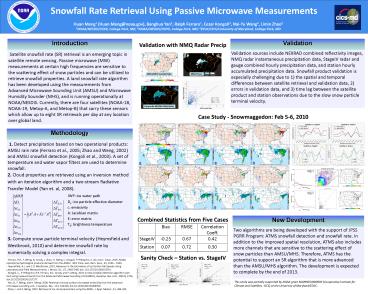Snowfall Rate Retrieval Using Passive Microwave Measurements - PowerPoint PPT Presentation
1 / 1
Title:
Snowfall Rate Retrieval Using Passive Microwave Measurements
Description:
Snowfall Rate Retrieval Using Passive Microwave Measurements Huan Meng1 (Huan.Meng_at_noaa.gov), Banghua Yan2, Ralph Ferraro1, Cezar Kongoli3, Nai-Yu Wang3, Limin Zhao2 – PowerPoint PPT presentation
Number of Views:97
Avg rating:3.0/5.0
Title: Snowfall Rate Retrieval Using Passive Microwave Measurements
1
Snowfall Rate Retrieval Using Passive Microwave
Measurements
Huan Meng1 (Huan.Meng_at_noaa.gov), Banghua Yan2,
Ralph Ferraro1, Cezar Kongoli3, Nai-Yu Wang3,
Limin Zhao2 1NOAA/NESDIS/STAR, College Park, MD
2NOAA/NESDIS/OSPO, College Park, MD
3ESSIC/CICS/University of Maryland, College Park,
MD
Introduction
Validation
Validation with NMQ Radar Precip
Satellite snowfall rate (SR) retrieval is an
emerging topic in satellite remote sensing.
Passive microwave (MW) measurements at certain
high frequencies are sensitive to the scattering
effect of snow particles and can be utilized to
retrieve snowfall properties. A land snowfall
rate algorithm has been developed using the
measurements from Advanced Microwave Sounding
Unit (AMSU) and Microwave Humidity Sounder (MHS),
and is running operationally at NOAA/NESDIS.
Currently, there are four satellites (NOAA-18,
NOAA-19, Metop-A, and Metop-B) that carry these
sensors which allow up to eight SR retrievals per
day at any location over global land.
Validation sources include NEXRAD combined
reflectivity images, NMQ radar instantaneous
precipitation data, StageIV radar and gauge
combined hourly precipitation data, and station
hourly accumulated precipitation data. Snowfall
product validation is especially challenging due
to 1) the spatial and temporal differences
between satellite retrieval and validation data,
2) errors in validation data, and 3) time lag
between the satellite product and station
observations due to the slow snow particle
terminal velocity.
AMSU/MHS Snowfall Rate
NMQ Phase
Composite NEXRAD Reflectivity
Case Study - Snowmaggedon Feb 5-6, 2010
Methodology
1. Detect precipitation based on two operational
products AMSU rain rate (Ferraro et al., 2005
Zhao and Weng, 2002) and AMSU snowfall detection
(Kongoli et al., 2003). A set of temperature and
water vapor filters are used to determine
snowfall. 2. Cloud properties are retrieved
using an inversion method with an iteration
algorithm and a two-stream Radiative Transfer
Model (Yan et. al, 2008).
IWP ice water path
De ice particle effective
diameter
e emissivity
A Jacobian matrix
E error
matrix
TB brightness
temperature 3. Compute snow particle terminal
velocity (Heymsfield and Westbrook, 2010) and
determine snowfall rate by numerically solving a
complex integral.
SFR (mm/hr)
Bias RMSE Correlation Coeff.
StageIV -0.23 0.67 0.42
Station 0.07 0.72 0.30
Combined Statistics from Five Cases
New Development
Two algorithms are being developed with the
support of JPSS PGRR Program ATMS snowfall
detection and snowfall rate. In addition to the
improved spatial resolution, ATMS also includes
more channels that are sensitive to the
scattering effect of snow particles than
AMSU/MHS. Therefore, ATMS has the potential to
support an SR algorithm that is more advanced
than the AMSU/MHS algorithm. The development is
expected to complete by the end of 2013.
Sanity Check Station vs. StageIV
- Ferraro, R.R., F. Weng, N. Grody, L. Zhao, H.
Meng, C. Kongoli, P. Pellegrino, S. Qiu and C.
Dean, 2005 NOAA operational hydrological
products derived from the AMSU. IEEE Trans. Geo.
Rem. Sens., 43, 1036 1049. - Heymsfield, A.J. and C.D. Westbrook, 2010,
Advances in the Estimation of Ice Particle Fall
Speeds Using Laboratory and Field Measurements.
J. Atmos. Sci., 67, 2469-2482 doi
10.1175/2010JAS3379.1 - - Kongoli, C., P. Pellegrino, R.R. Ferraro, N.C.
Grody, and H. Meng, 2003. A new snowfall
detection algorithm over land using measurements
from the Advanced Microwave Sounding Unit (AMSU),
Geophys. Res. Lett., 30(14), 1756,
doi10.1029/2003GL017177. - Yan, B., F. Weng, and H. Meng, 2008. Retrieval
of snow surface microwave emissivity from the
advanced microwave sounding unit, J. Geophys.
Res., 113, D19206, doi10.1029/2007JD009559. - Zhao, L. and F. Weng, 2002 Retrieval of ice
cloud parameters using the AMSU. J. Appl.
Meteor., 41, 384-295.
This study was partially supported by NOAA grant
NA09NES4400006 (Cooperative Institute for Climate
and Satellites -CICS) at the University of
Maryland/ESSIC.































